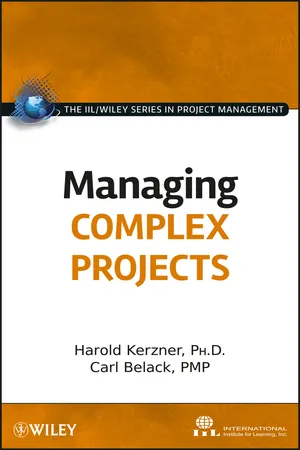![]()
Chapter 1
PROJECT MANAGEMENT FRAMEWORK
PROJECT CHARACTERISTICS
• Have a specific objective (which may be unique or one-of-a-kind) to be completed within certain specifications
• Have defined start and end dates
• Have funding limits (if applicable)
• Have quality limits (if applicable)
• Consume human and nonhuman resources (i.e., money, people, equipment)
• Be multifunctional (cut across several functional lines)
We must begin with the definition of a project. Projects are most often unique endeavors that have not been attempted before and might never be attempted again. Projects have specific start and end dates. In some cases, projects may be very similar or identical and repetitive in nature, but those situations would be an exception rather than the norm. Because of the uniqueness of projects and their associated activities, estimating the work required to complete the project may be very difficult and the resulting estimates may not be very reliable. This may create a number of problems and challenges for the functional manager.
Projects have constraints or limitations. Typical constraints include time frames with predetermined milestones, financial limitations, and limitations regarding quality as identified in the specifications. Another typical constraint may be the tolerance for risk and the amount of risk that the project team or owner can accept. There may also be limitations on the quality and skill levels of the resources needed to accomplish the tasks.
Projects consume resources. Resources are defined as human—people providing the labor and support; and nonhuman—equipment, facilities, and money, for example.
Projects are also considered to be multifunctional, which means that projects are integrated and cut across multiple functional areas and business entities. One of the primary roles of the project manager is to manage the integration of project activities. The larger the project, and the greater the number of boundaries to be crossed, the more complex the integration becomes.
THE COMPLEXITY OF DEFINING COMPLEXITY
Projects are usually defined as being complex according to one or more of the following elements interacting together:
• Size
• Dollar value
• Uncertain requirements
• Uncertain scope
• Uncertain deliverables
• Complex interactions
• Uncertain credentials of labor pool
• Geographic separation across multiple time zones
• Other factors
Complex projects differ from traditional projects for a multitude of reasons, many of which are shown in the following feature. There are numerous definitions of a complex project. The projects that you manage within your own company can be regarded as a complex project if the scope is large and the statement of work only partially complete.
Some people believe that research and development (R&D) projects are always complex because, if you can lay out a plan for R&D, then you probably do not have R&D. R&D is when you are not 100 percent sure where you are heading, you do not know what it will cost, and you do not know when you will get there.
Complexity can also be defined according to the number of interactions that must take place for the work to be executed. The greater the number of functional units that must interact, the harder it is to perform the integration. The situation becomes more difficult if the functional units are dispersed across the globe and if cultural differences makes integration difficult.
Complexity can also be defined according to size and length. The larger the project in scope and cost, and the greater the time frame, the more likely it is that scope changes will occur affecting the budget and schedule. Large, complex projects tend to have large cost overruns and schedule slippages. Good examples of this are Denver International Airport, the Chunnel between England and France, and the “Big Dig” in Boston.
COMPONENTS OF COMPLEX PROJECTS
For the purposes of this book, we will consider complex projects to be defined according to the five elements shown in the preceding feature:
• Size and cost. According to size, we shall assume that this project is possibly one of the largest and most costly projects that you have ever worked on. The budget could be in hundreds of millions or, if your company works on projects up to $5 million, then this project might be $20 million. Furthermore, the project is being accomplished for a client external to your company.
• Interactions. You must interface with several subcontractors or suppliers, and many of them may be in different time zones. You are most likely using a virtual team concept for all or part of the people you must interface with.
• Cultural implications. Because some or all of your team members may come from various locations around the globe, cultural differences can have a severe effect on the management of the project.
• Uncertainty. This project is unlike any other project you have managed, and there is a great deal of uncertainty. The uncertainty deals with not only the scope and the deliverables, but also with the size of the project team and the cultural differences.
• Stakeholders. There are several stakeholders that you must interface with, and getting them all to agree on the scope, the deliverables, and the approval of change requests will be difficult. Stakeholders may have their own agendas for the project, and each stakeholder may have funded part of the project.
THE TRIPLE CONSTRAINT
Project management is an attempt to improve efficiency and effectiveness in the use of resources by getting work to flow multidirectionally through an organization. This holds true for both traditional projects and complex projects. Initially, this might seem easy to accomplish, but there are typically a number of constraints imposed on a project. The most common constraints are time, cost, and performance (also referred to as scope or quality), known as the triple constraints.3
From an executive management perspective, the preceding feature is the goal of project management, namely, meeting the triple constraints of time, cost, and performance while maintaining good customer relations. Unfortunately, because most projects have some unique characteristics, highly accurate estimates may not be possible, and trade-offs among the triple constraints may be necessary. Executive management and functional management must be involved in almost all trade-off discussions to ensure that the final decision is made in the best interest of both the project and the company. If multiple stakeholders are involved, as there are on complex projects, then agreement from all of the stakeholders may be necessary. Project managers may possess sufficient knowledge for some technical decision making, but may not have sufficient business or technical knowledge to adequately determine the best course of action to address interests of the company as well as the project.
The preceding feature shows that resources are consumed on a project. Typical traditional resources include money, manpower, information, equipment, facilities, and materials. Assuming that the project manager and functional manager are separate roles assigned to different people, the resources are generally administratively under the control of the functional managers. The project managers must therefore negotiate with the functional managers for some degree of control over these resources. It is not uncommon for project managers to have minimal or no direct control over project resources and to rely heavily on the functional managers for resource-related issues. The resources may be in a solid line type of reporting relationship to their functional manager and dotted line or indirect reporting to the project manager. The solid-dotted line relationship can become quite difficult to manage if the resources are under the control of functional managers geographically separated from the project manager.
Some people argue that project managers have direct control over all budgets associated with a project. The truth of the matter is that project managers have the right to open and close charge numbers or cost accounts for a project. But once the charge numbers are opened, the team members performing the work and their respective functional managers are actually in control of how the money is being spent as long as the charge number limits are not exceeded. With geographically dispersed teams, the problem of monitoring and controlling funds can create monumental headaches. Currency exchange rates also add to the complexity.
SECONDARY SUCCESS FACTORS
Secondary Factors
• Customer reference
• Commercialization
• Follow-on work
• Financial success
• Technical superiority
• Strategic alignment
• Regulatory agency relationships
• Health and safety
• Environmental protection
• Corporate reputation
• Employee alignment
• Ethical conduct (Sarbanes-Oxley law)
In the previous features, we discussed that time, cost, and performance were the primary components to the triple constraint. Project success is usually measured by how well we perform within the triple constraint. While that is true, there are secondary constraints that can be of greater importance to stakeholders than the primary constraints. As an example, a company agreed to execute a contract for a client at a contract price that was 40 percent below their own cost of doing the work. When asked why they bid on the contract at such a low price and knew full well that they would be losing money, an executive said: “We are doing this only once. We need to the client’s name on our resume of clients that we have serviced.” In this case, the contractor’s definition of success was customer reference.
In another example, the R&D group of a manufacturer of paint products stated that their definition of success was measured by product commercialization. Any R&D project that eventually gets commercial...



